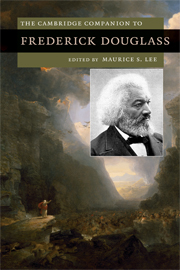Book contents
- Frontmatter
- Introduction
- 1 Douglass’s Self-Making and the Culture of Abolitionism
- 2 Identity in the Autobiographies
- 3 Douglass as Orator and Editor
- 4 Crisis and Faith in Douglass’s Work
- 5 Violence, Manhood, and War in Douglass
- 6 Human Law and Higher Law
- 7 Sentimental Douglass
- 8 Douglass among the Romantics
- 9 Douglass’s Black Atlantic: Britain, Europe, Egypt
- 10 Douglass’s Black Atlantic: The Caribbean
- 11 Douglass, Ideological Slavery, and Postbellum Racial Politics
- 12 Born into Slavery: Echoes and Legacies
- Guide to Further Reading
- Index
9 - Douglass’s Black Atlantic: Britain, Europe, Egypt
Published online by Cambridge University Press: 28 July 2009
- Frontmatter
- Introduction
- 1 Douglass’s Self-Making and the Culture of Abolitionism
- 2 Identity in the Autobiographies
- 3 Douglass as Orator and Editor
- 4 Crisis and Faith in Douglass’s Work
- 5 Violence, Manhood, and War in Douglass
- 6 Human Law and Higher Law
- 7 Sentimental Douglass
- 8 Douglass among the Romantics
- 9 Douglass’s Black Atlantic: Britain, Europe, Egypt
- 10 Douglass’s Black Atlantic: The Caribbean
- 11 Douglass, Ideological Slavery, and Postbellum Racial Politics
- 12 Born into Slavery: Echoes and Legacies
- Guide to Further Reading
- Index
Summary
The Dialogue with Garrison
The initial impetus to institutionalize Frederick Douglass in the American literary canon in the 1970s was linked primarily to the renewed visibility and popularity of his first autobiography, Narrative of the Life of Frederick Douglass (1845). For critics in the Civil Rights era still working within the academic framework established by F. O. Matthiessen’s American Renaissance (1941), it became relatively easy to establish Douglass as the missing racial element within the orbit of an American literary nationalism thought to be centered on the masculine genius of a heroic Transcendentalism. We know that Douglass read and admired Emerson, and there are indeed many structural parallels between the writings of Emerson (and Thoreau) and Douglass’s 1845 Narrative. There is a similar stress on self-reliance, on a quest for personal freedom; there is an emphasis on oratorical power and emotional authenticity, generated in part by Douglass’s performances on the abolitionist lecture circuit in the early 1840s under the patronage of William Lloyd Garrison; there is a philosophical temper of Idealism, whereby, in dramatically dualistic terms, the “dark night” of slavery is contrasted with an image of unfettered freedom, sailing ships “robed in purest white, so delightful to the eye of freemen” (N 58-59). Although the Narrative of course inflects racial politics differently than Transcendentalism, its underlying rhetorical strategies involving a passage from bondage to freedom are curiously similar, and, not surprisingly, various critics have commented on ways in which this work appropriates familiar tropes of the American literary tradition.
- Type
- Chapter
- Information
- The Cambridge Companion to Frederick Douglass , pp. 132 - 145Publisher: Cambridge University PressPrint publication year: 2009
- 21
- Cited by



